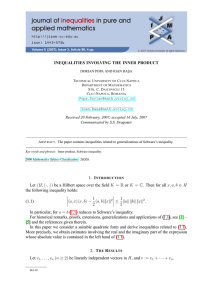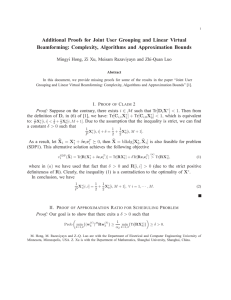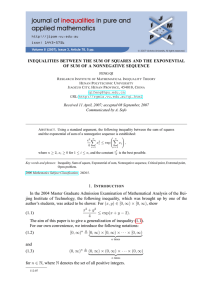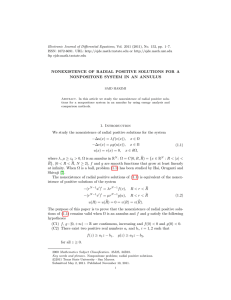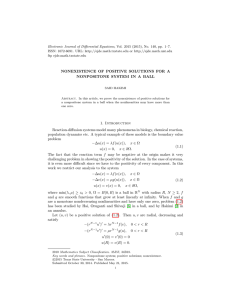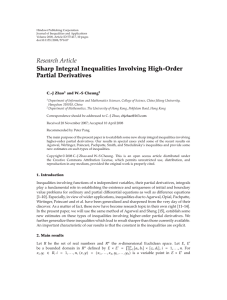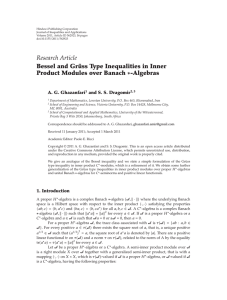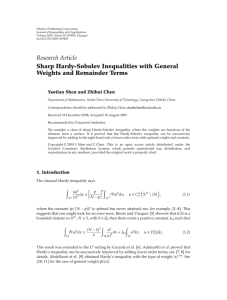Document 10773393
advertisement
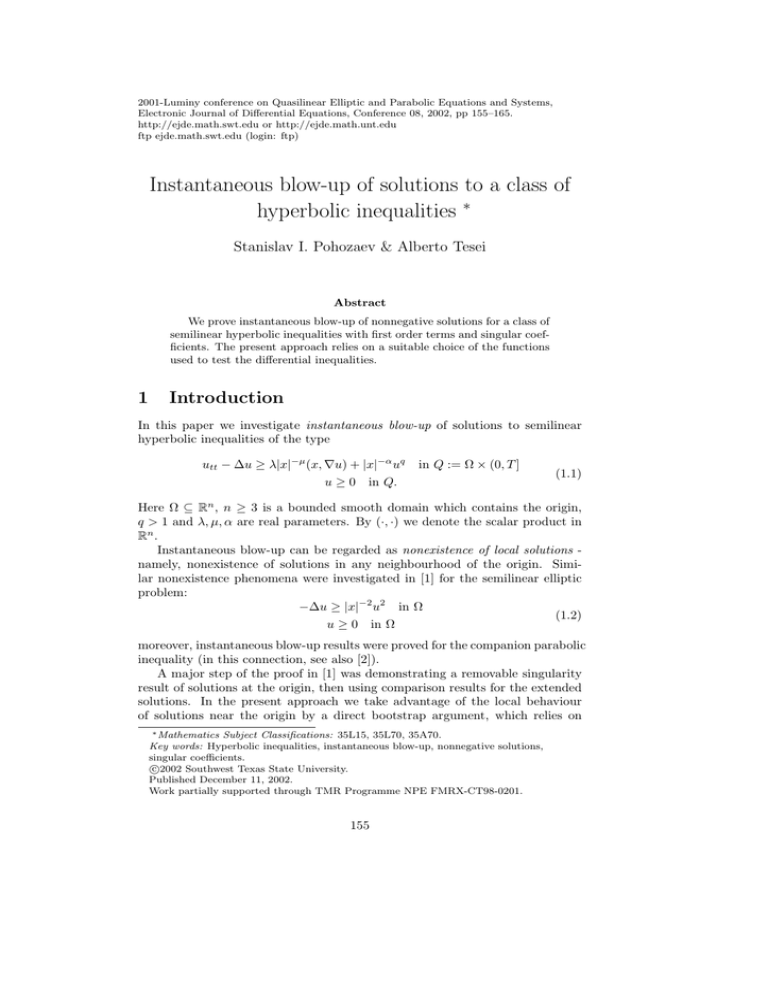
2001-Luminy conference on Quasilinear Elliptic and Parabolic Equations and Systems,
Electronic Journal of Differential Equations, Conference 08, 2002, pp 155–165.
http://ejde.math.swt.edu or http://ejde.math.unt.edu
ftp ejde.math.swt.edu (login: ftp)
Instantaneous blow-up of solutions to a class of
hyperbolic inequalities ∗
Stanislav I. Pohozaev & Alberto Tesei
Abstract
We prove instantaneous blow-up of nonnegative solutions for a class of
semilinear hyperbolic inequalities with first order terms and singular coefficients. The present approach relies on a suitable choice of the functions
used to test the differential inequalities.
1
Introduction
In this paper we investigate instantaneous blow-up of solutions to semilinear
hyperbolic inequalities of the type
utt − ∆u ≥ λ|x|−µ (x, ∇u) + |x|−α uq
u ≥ 0 in Q.
in Q := Ω × (0, T ]
(1.1)
Here Ω ⊆ Rn , n ≥ 3 is a bounded smooth domain which contains the origin,
q > 1 and λ, µ, α are real parameters. By (·, ·) we denote the scalar product in
Rn .
Instantaneous blow-up can be regarded as nonexistence of local solutions namely, nonexistence of solutions in any neighbourhood of the origin. Similar nonexistence phenomena were investigated in [1] for the semilinear elliptic
problem:
−∆u ≥ |x|−2 u2 in Ω
(1.2)
u ≥ 0 in Ω
moreover, instantaneous blow-up results were proved for the companion parabolic
inequality (in this connection, see also [2]).
A major step of the proof in [1] was demonstrating a removable singularity
result of solutions at the origin, then using comparison results for the extended
solutions. In the present approach we take advantage of the local behaviour
of solutions near the origin by a direct bootstrap argument, which relies on
∗ Mathematics Subject Classifications: 35L15, 35L70, 35A70.
Key words: Hyperbolic inequalities, instantaneous blow-up, nonnegative solutions,
singular coefficients.
c
2002
Southwest Texas State University.
Published December 11, 2002.
Work partially supported through TMR Programme NPE FMRX-CT98-0201.
155
156
Stanislav I. Pohozaev & Alberto Tesei
a proper choice of the test functions; no comparison results are needed. This
allows us to deal not only with elliptic or parabolic inequalities (see [6]), but
also with the hyperbolic case (1.1). Let us mention that the same approach was
used elsewhere (e.g., see [3], [5]; a comprehensive account can be found in [4]).
A specific aim of the present paper is to investigate how singular first order
terms affect existence of local solutions to problem (1.1). As long as µ ≤ 2,
nonexistence results are proven only if α ≥ 2 (see assumptions (a)-(b) of Theorem 2.2 below); in this case nonexistence of local solutions depends on the
2q
singularity of the source term as in [1]. On the other hand, if µ > q−1
nonexistence can be proved also for α < 0 (see assumption (c) of Theorem 2.2); in
this case the coefficient of the source term is regular in Ω, thus the nonexistence
result depends on the singularity of the first order term. The same situation
occurs for elliptic or parabolic inequalities analogous to (1.1) (see [6]).
2
Mathematical background and results
Solutions to problem (1.1) are meant in the following sense.
Definition 2.1 By a solution to problem (1.1) in Q := Ω × (0, T ] we mean any
1
function u ∈ C([0, T ]; Hloc
(Ω \ {0})) ∩ C 1 ([0, T ]; Lqloc (Ω \ {0})) such that:
(i) u ≥ 0 almost everywhere in Q;
∞,2
(ii) for any test function ζ ∈ Cx,t
(Q̄), ζ ≥ 0, ζ(·, t) ∈ C0∞ (Ω \ {0}) (t ∈ [0, T ]),
ζ(·, T ) = ζt (·, T ) = 0 there holds:
ZZ
ZZ
(∇u, ∇ζ) + λ
u div |x|−µ xζ
Q
Q
ZZ
Z
Z
ZZ
−α q
≥
|x| u ζ +
ut (x, 0)ζ(x, 0) −
u(x, 0)ζt (x, 0) −
uζtt . (2.1)
Q
Ω
Ω
Q
The following nonexistence result will be proven.
Theorem 2.2 Let either of the following assumptions be satisfied:
(a) µ < 2, α ≥ 2
(b) µ = 2 and either α > 2, λ ≥ 2 − n, or α = 2, λ > 2 − n
(c) µ > 2, α > µ + (2 − µ)q, and λ > 0.
Moreover, let
lim inf |x|−γ u(x, 0) > 0
(2.2)
ut (x, 0) ≥ 0
(2.3)
x→0
for some γ < 0 and
in some neighbourhood of the origin. Then the only solution to problem (1.1) in
any cylinder Ω1 × (0, τ ], Ω1 ⊆ Ω containing the origin and τ ∈ (0, T ), is trivial.
Instantaneous blow-up of solutions
157
Remark 2.3 With the exception of the case α = 2, Theorem 2.2 still holds if
α
in (2.2).
we assume γ < q−1
The proof of Theorem 2.2 relies on a proper choice of the test function in
inequality (2.1). For this purpose we introduce some preliminary material.
Let Ω1 ⊆ Ω be any neighbourhood containing the origin, 0 < < η, η > 2
so small that A,η := {x ∈ Rn : < |x| < η} ⊆ Ω1 \ {0}. For r ∈ [, η] define
φ0 (r) := rσ − η σ ,
where σ < 0 will be fixed later. Define also
r
φ1 (r) := φ̄( ) (r ∈ [, η]),
η
∞
where φ̄ ∈ C ([0, ]) is nondecreasing, such that
(
0 if s ∈ (0, 1)
φ̄(s) :=
1 if s ∈ (2, η/).
Finally, set
ζ̄(r) := rρ φ0 (r)φ1 (r)
(r ∈ [, η]),
where ρ is a real parameter to be chosen later.
Remark 2.4 The following properties of the function ζ̄ are easily checked.
(i) There holds:
dζ̄
() ≥ 0,
dr
ζ̄() = ζ̄(η) = 0;
dζ̄
(η) ≤ 0.
dr
(ii) There exists a sequence {ζk } ⊆ C0∞ (A,η ), ζk ≥ 0 for any k, such that ζk → ζ̃
in W01,p (A,η ) (p ∈ (1, ∞)), where
ζ̃(x) := ζ̄(|x|) (x ∈ Ā,η ).
3
(2.4)
Proofs
Let us prove the following result.
Proposition 3.1 Let u be a solution to problem (1.1) in some cylinder Ω1 ×
(0, τ ] ⊆ Q, Ω1 containing the origin and τ ∈ (0, T ). Then for any 0 < < η, η
sufficiently small and any τ ∈ (0, T ) there holds:
Z τ
Z
(τ − t)β dt
|x|−α uq (x, t)ζ̃(x)
0
A,η
≤−
Z
τ
β
(τ − t) dt
0
|x|−(n−1)
A,η
+ β(β − 1)
Z
0
− τβ
Z
Z
A,η
τ
(τ − t)β−2 dt
dψ
(|x|)u(x, t)
dr
Z
u(x, t)ζ̃(x)
A,η
ut (x, 0)ζ̃(x) − βτ β−1
Z
A,η
u(x, 0)ζ̃(x),
(3.1)
158
Stanislav I. Pohozaev & Alberto Tesei
where β >
q+1
q−1 ,
ζ̃ is the function (2.4) and
ψ(r) := rn−1
dζ̄
(r) − λrn−µ ζ̄(r)
dr
(r ∈ [, η]).
(3.2)
Let τ ∈ (0, T ); set
Proof.
(
(τ − t)β
φ̂(t) :=
0
if t ∈ (0, τ )
if t ∈ (τ, T ) .
Let {ζk } ⊆ C0∞ (A,η ) be the approximating sequence in Remark 2.4-(ii); set
ζ(x, t) = ζk (x)φ̂(t) in inequality (2.1). Letting k → ∞ we obtain easily:
Z τ
Z
(τ − t)β dt
|x|−α uq (x, t)ζ̃(x)
0
A,η
≤
Z
τ
(τ − t)β dt
0
Z
(∇u(x, t), ∇ζ̃) + λ
A,η
+ β(β − 1)
Z
β
Z
u(x, t) div |x|−µ xζ
A,η
τ
(τ − t)β−2 dt
0
−τ
Z
Z
u(x, t)ζ̃(x)
A,η
ut (x, 0)ζ̃(x) − βτ
β−1
Z
A,η
u(x, 0)ζ̃(x) .
A,η
On the other hand, for any t ∈ (0, τ ) there holds:
Z
A,η
(∇u(x, t), ∇ζ̃) + λ
Z
A,η
u(x, t) div |x|−µ xζ
≤−
Z
A,η
n
u(x, t) ∆ζ̃ − λ div |x|−µ xζ .
An elementary calculation shows that
dψ
∆ζ̃ − λ div |x|−µ xζ = |x|−(n−1) (|x|);
dr
Then from the above inequalities the conclusion follows.
It is easily checked that the function ψ defined in (3.2) reads:
ψ = φ1 ψ1 + rn−1+ρ φ0
dφ1
,
dr
(3.3)
where
ψ1 = ψ1 (r) := rn−1
d ρ
[r φ0 (r)] − λrn−µ+ρ φ0 (r)
dr
(r ∈ [, η]).
The following technical lemma plays an important role in the sequel.
Lemma 3.2 Let any of the following assumptions be satisfied:
Instantaneous blow-up of solutions
159
• (i) µ < 2, ρ ≤ 2 − n, σ < 0
• (ii) µ < 2, ρ ∈ (2 − n, 0), ρ ≤ 4 − n − µ, σ = −ρ + 2 − n
• (iii) µ = 2, ρ ≤ 2 − n ≤ λ, σ < 0
• (iv) µ = 2, ρ = λ > 2 − n, σ = −ρ + 2 − n
• (v) µ > 2, ρ ≤ µ − n, λ > 0, σ < 0.
Then there exists η0 > 0 (depending on n, λ, µ, ρ, σ) such that for any η < η0
there holds
dψ1
≥ 0 in (, η) .
(3.4)
dr
Proof .
We deal only with cases (i)-(ii) for shortness. Observe that
dψ1
r
= rn−3+ρ+σ ψ0 ( ),
dr
η
where
ψ0 (s) :=(ρ + σ)(n − 2 + ρ + σ) − ρ(n − 2 + ρ)s−σ
h
i
− λ (n − µ + ρ + σ) − (n − µ + ρ)s−σ η 2−µ s2−µ
(s ∈ [0, 1]),
as an elementary calculation shows.
(i) Since ρ ≤ 2 − n ≤ 0 and σ < 0, there holds
(ρ + σ)(n − 2 + ρ + σ) − ρ(n − 2 + ρ)s−σ
≥ (ρ + σ)(n − 2 + ρ + σ) − ρ(n − 2 + ρ) > 0 ;
in fact, it is easily seen that the function f (s) := s(n−2+s) is strictly increasing
in the interval [ρ + σ, ρ]. Since by assumption 2 − µ > 0, choosing η sufficiently
small, we prove the claim.
(ii) In this case n − 2 + ρ + σ = 0 and −ρ(n − 2 + ρ) > 0; since 2 − µ + σ =
4 − n − µ − ρ ≥ 0, the claim follows as in (i).
In the remaining cases we can argue similarly; hence the conclusion follows.
Then we have the following result.
Proposition 3.3 Let u be a solution to problem (1.1) in some cylinder Ω1 ×
(0, τ ] ⊆ Q, Ω1 containing the origin and τ ∈ (0, T ). Let the assumptions of
Lemma 3.2 be satisfied; choose η < η0 accordingly. Moreover, let
ρ+σ >−
α
− n.
q−1
(3.5)
160
Stanislav I. Pohozaev & Alberto Tesei
Then for any > 0 sufficiently small and any τ ∈ (0, T ) there holds:
Z τ
q
Z
β
(τ − t) dt
u(x, t)ζ̃(x)
0
A,η
1
2
C1 (, η) C1 (, η) q−1 τ − q−1 + C2 (, η)τ 2
Z
Z
−τ
ut (x, 0)ζ̃(x) −
u(x, 0)ζ̃(x) ,
≤M τ
β−1
A,η
(3.6)
A,η
for some constant M = M (β, q) > 0. Here
q−1
Z η α
,
C1 (, η) :=
r q−1 +n−1 ζ̄(r)dr
Z
h
i−(q0 −1)
0
0
C2 (, η) :=
|x|−(n−1)q |x|−α ζ̃(x)
χ(|x|)q dx .
(3.7)
(3.8)
A,η
(i) Due to Lemma 3.2 and the choice η < η0 , for any t ∈ (0, τ ) we have
Z
−(n−1) dψ
−
|x|
(|x|)u(x, t) ≤ −
|x|−(n−1) χ(|x|)u(x, t),
(3.9)
dr
A,η
A,η
Proof.
Z
where
dφ1
d
dφ1
ψ1 + [rn−1+ρ φ0
] (r ∈ [, η]).
(3.10)
dr
dr
dr
Using Hölder inequality, the right-hand side of inequality (3.9) can be estimated
as follows
Z
|x|−(n−1) χ(|x|)u(x, t)
χ(r) :=
A,η
0
−(q0 −1)
0
0 1/q
|x|−(n−1)q |x|−α ζ̃(x)
χ(|x|)q
≤
Z
1/q Z
|x|−α uq (x, t)ζ̃(x)
=
Z
1/q 1/q0
|x|−α uq ζ̃(x)
C2 (, η)
A,η
A,η
A,η
(3.11)
q
(see definition (3.8); here q 0 := q−1
). Using inequality (3.11) and Young inequality we obtain
1
Z
1 Z
|x|−(n−1) χ(|x|)u(x, t) ≤ |x|−α uq (x, t)ζ̃(x) + 0 C2 (, η) (3.12)
q
q
A,η
A,η
for any t ∈ (0, τ ). Then from inequalities (3.12), (3.9) we obtain for any t ∈
(0, τ ):
Z τ
Z
dψ
−
(τ − t)β dt
|x|−(n−1) (|x|)u(x, t)
dr
0
A,η
Z τ
Z
1
1 τ β+1
≤
(τ − t)β dt
|x|−α uq (x, t)ζ̃(x) + 0
C2 (, η).
q 0
q β+1
A,η
Instantaneous blow-up of solutions
161
Substituting the above inequality in (3.1) easily gives
Z τ
Z
β
(τ − t) dt
|x|−α uq (x, t)ζ̃(x) dt
0
A,η
τ β+1
≤
C2 (, η) + β(β − 1)q 0
β+1
τ
Z
Z
(τ − t)β−2 dt
0
(3.13)
u(x, t)ζ̃(x)
A,η
− q 0 τ β v 0 (0) − q 0 βτ β−1 v(0) .
(ii) Observe that for any t ∈ (0, τ ),
Z
Z
1/q Z
−α q
u(x, t)ζ̃(x) ≤
|x| u (x, t)ζ̃(x)
A,η
A,η
Z
=
A,η
A,η
η
1/q Z
|x|−α uq (x, t)ζ̃(x)
1/q0
α
|x| q−1 ζ̃(x)
α
r q−1 +n−1 ζ̄(r)dr
Set
Z
v(t) :=
1/q0
.
t ∈ (0, τ ) .
u(x, t)ζ̃(x),
A,η
Then by definition (3.7) the above inequality reads
Z
v q (t) ≤ C1 (, η)
|x|−α uq (x, t)ζ̃(x)
(3.14)
A,η
for any t ∈ (0, τ ). Then from inequalities (3.14), (3.13) we get
Z τ
Z τ
h τ β+1
β q
0
(τ − t) v (t) dt ≤C1 (, η)
C2 (, η) + β(β − 1)q
(τ − t)β−2 dt
β+1
0
0
Z
i
×
u(x, t)ζ̃(x) − q 0 τ β v 0 (0) − q 0 βτ β−1 v(0) .
A,η
(3.15)
(iii) Due to Young inequality,
Z τ
0
β(β − 1)q C1 (, η)
(τ − t)β−2 v(t) dt
0
≤
1
q
Z
0
q 0 −1
0
τ
(τ − t)β v q (t) dt +
[β(β − 1)]q (q 0 )
β − 2q 0 + 1
(here we used the assumption β >
(3.13) we obtain
Z τ
1
(1− )
(τ − t)β v q (t) dt
q 0
q+1
q−1 ).
0
From the previous inequality and
0
≤
0
C1q (, η)τ β−2q +1
q 0 −1
0
0
τ β+1
[β(β − 1)]q (q 0 )
C1 (, η)C2 (, η) +
C1q (, η)τ β−2q +1
0
β+1
β − 2q + 1
− q 0 C1 (, η)τ β v 0 (0) − q 0 C1 (, η)βτ β−1 v(0) .
162
Stanislav I. Pohozaev & Alberto Tesei
Then the conclusion follows.
Let us now proceed to prove Theorem 1.1. Observe that, due to assumption
(2.3), from inequality (3.6), we obtain
Z τ
Z
q
β
(τ − t) dt
u(x, t)ζ̃(x)
(3.16)
0
≤ Mτ
A,η
β−1
Z
n
1
2
− q−1
2
q−1
τ
+ C2 (, η)τ −
C1 (, η) C1 (, η)
A,η
o
u(x, 0)ζ̃(x) .
We will estimate the various terms in inequality (3.16) as → 0+ . This motivates the following considerations:
(α) Observe that for any t ∈ [0, τ ],
Z
Z
h
η σ i
lim+
u(x, t)ζ̃(x) =
|x|ρ+σ 1 −
u(x, t)
|x|
→0
A,η
Bη
by monotonicity, due to the choice of the function ζ̃. Moreover, due to assumption (2.2), there exist k > 0 and η1 > 0 such that for any |x| < η < η1 there
holds: u(x, 0) ≥ k|x|γ . Hence
Z η
Z
h
η σ i
h
η σ i
ρ+σ
|x|
1−
u(x, 0)dx ≥ k
rγ+ρ+σ+n−1 1 −
dr .
|x|
r
Bη
0
If γ ≤ −2, the integral in the right-hand side of the above inequality diverges.
On the other hand, if γ > −2 we obtain:
Z
h
η σ i
u(x, 0)dx ≥ Kη γ+ρ+σ+n
|x|ρ+σ 1 −
|x|
Bη
for some K > 0.
(β) Concerning the coefficient C1 (, η) we have (see definition (3.7))
Z η α
q−1
C1 (, η) ≤
r q−1 +ρ+σ+n−1 dr
;
thus, by monotonicity
lim C1 (, η) ≤ Lη α+(ρ+σ+n)(q−1)
→0+
for some L > 0, provided that condition (3.5) is satisfied.
(γ) As for the coefficient C2 (, η), we claim that
C2 (, η) = C2 (, 2) ≤ C̄θ
(3.17)
for some constant C̄ > 0, where
θ := n − α + ρ + σ + (α − 2)
q
.
q−1
(3.18)
Instantaneous blow-up of solutions
163
In fact, let us estimate the integral in the right-hand side of inequality (3.8). To
this purpose, set s := r ∈ [1, 2]. It is easily seen that
ζ̄(s) ≥ c1 ρ+σ φ̄(s),
χ(s) ≤ c2 n−3+ρ+σ [φ̄0 (s) + φ̄00 (s)],
for some c1 , c2 > 0 and any s ∈ [1, 2]; here we used the equalities
φ1 (s) = φ̄(s),
dφ1
φ̄0 (s)
(s) =
,
dr
d2 φ1
φ̄00 (s)
(s) =
.
2
dr
2
q+1
Moreover, choosing φ̄(s) = O((s − 1)γ ) with γ > max{2, q−1
} as s → 1+ , we
obtain
Z 2h 0 qi 1
Z 2 h 00 q i 1
φ̄ (s) q−1
φ̄ (s) q−1
< ∞,
< ∞.
φ̄(s)
φ̄(s)
1
1
It follows that
Z
2
h
1
i− q−1
q
χ(r) q−1 dr ≤ C̃θ
rn−α−1 ζ̄(r)
(3.19)
for some C̃ > 0, where
1
q
− (n − α − 1 + ρ + σ)
+1
q−1
q−1
q
.
=n − α + ρ + σ + (α − 2)
q−1
θ :=(n − 3 + ρ + σ)
This proves the claim.
Proof of Theorem 1.1 Suppose that assumption (a) is satisfied. (the proof
cases (b)-(c) being the same we omit them).
(i) Let µ < 2, α > 2. In this case we can choose the parameters ρ, σ so that both
assumption (i) of Lemma 3.2 and condition (3.5) are satisfied, and moreover the
exponent θ defined in (3.18) is positive .
Due to the above remarks (α)–(γ), taking the limit of inequality (3.16) as
→ 0+ gives
Z
0
τ
β
(τ − t) dt
nZ
oq
h
η σ i
|x|ρ+σ 1 −
u(x, t)dx
|x|
Bη
n
o
α
2
α
≤ M τ β η q−1 +ρ+σ+n τ − q−1 − Kη γ− q−1
for any τ ∈ (0, T ), if γ > −2. In this case the right-hand side of the above
inequality is negative for any τ > τ∗ = τ∗ (η) := K −(q−1) η α−γ(q−1) ; since
τ∗ (η) → 0+ as η → 0+ , the conclusion follows in this case.
On the other hand, if γ ≤ −2 the right-hand side of inequality (3.16) tends
to −∞ as → 0+ , thus a contradiction follows in this case, too. This proves
the result in the case α > 2.
164
Stanislav I. Pohozaev & Alberto Tesei
(ii) Let us assume µ < 2, α = 2. In this case we make the choice ρ + σ + n = 2,
so that both assumption (ii) of Lemma 3.2 and condition (3.5) are satisfied; the
above choice gives θ = 0. Taking the limit of inequality (3.16) as → 0+ , we
obtain
Z τ
nZ
h
η σ i
oq
n
o
β
(τ − t) dt
|x|ρ+σ 1 −
u(x, t)dx ≤ M τ β g(η, τ ) − Kη γ+2 ,
|x|
0
Bη
where
2q
2
g(η, τ ) := η q−1 τ − q−1 + C̄τ 2 .
It is easily seen that the function g(η, ·) has a unique minimum τ∗ = τ∗ (η) :=
q−1
[(q − 1)C̄]− 2q η in [0, T ]; moreover, g(η, τ∗ ) = q C̄τ∗2 . Then by the above inequality there holds:
Z τ
nZ
h
η σ i
oq
n
o
u(x, t) ≤ M 0 τ β+2 C̄ − Kη γ
(τ − t)β dt
|x|ρ+σ 1 −
|x|
0
Bη
for some M 0 > 0. Since γ < 0 and τ∗ (η) → 0+ as η → 0+ , the conclusion follows
in this case, too. This completes the proof.
References
[1] H. Brezis and X. Cabré, Some Simple Nonlinear PDE’s Without Solutions,
Boll. Un. Mat. Ital. 1-B (1998), 223-262.
[2] X. Cabre’ and Y. Martel, Existence versus Explosion Instantanée pour des
Equations de la Chaleur Linéaires avec Potentiel Singulier, C. R. Acad.
Sci. Paris 329 (1999), 973-978.
[3] E. Mitidieri and S. I. Pohozaev, The Absence of Global Positive Solutions
to Quasilinear Elliptic Inequalities, Dokl. Russ. Acad. Sci. 359 (1998), 456460.
[4] E. Mitidieri and S. I. Pohozaev, A Priori Estimates and Blow-Up of Solutions to Nonlinear Partial Differential Equations and Inequalities, Proc.
Steklov Inst. Math. 234 (International Academic Publishing, Moscow
2001).
[5] S.I. Pohozaev and A. Tesei, Blow-Up of Nonnegative Solutions to Quasilinear Parabolic Inequalities, Atti Accad. Naz. Lincei Rend. Cl. Sci. Fis. Mat.
Natur. 11 (2000), 99-109.
[6] S.I. Pohozaev and A. Tesei, Nonexistence of Local Solutions to Semilinear
Partial Differential Inequalities, Nota Scientifica 01/28, Dip. Mat. Universitá “ La Sapienza”, Roma (2001).
Instantaneous blow-up of solutions
Stanislav I. Pohozaev
Steklov Mathematical Institute, Russian Academy of Sciences,
Gubkina 8, 117966 Moscow, Russia
e-mail: pohozaev@mi.ras.ru
Alberto Tesei
Dipartimento di Matematica “G. Castelnuovo”,
Università di Roma “La Sapienza”, P.le A. Moro 5,
I-00185 Roma, Italia
e-mail: tesei@mat.uniroma1.it
165
